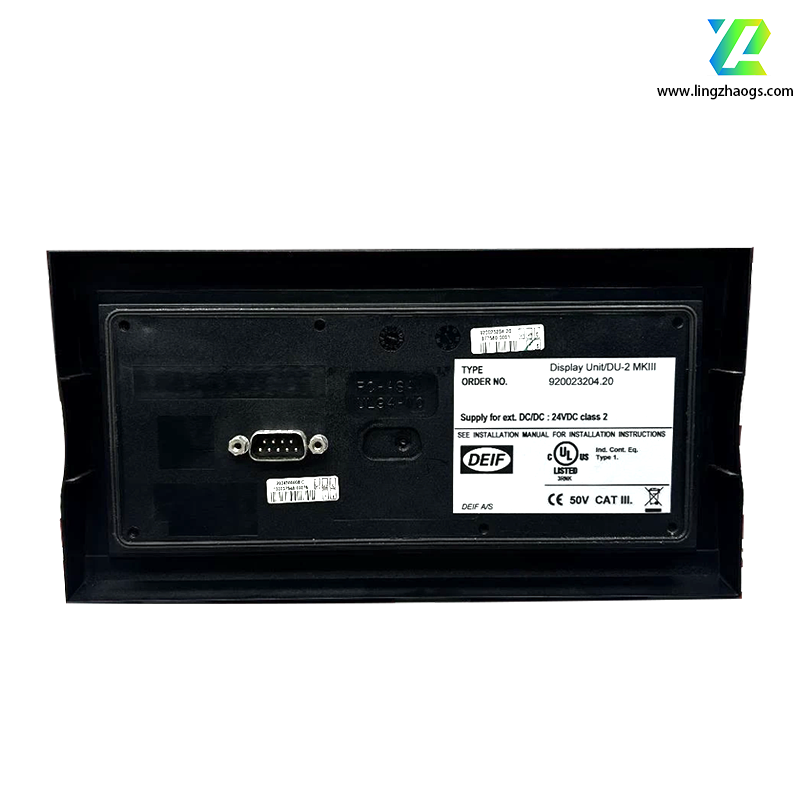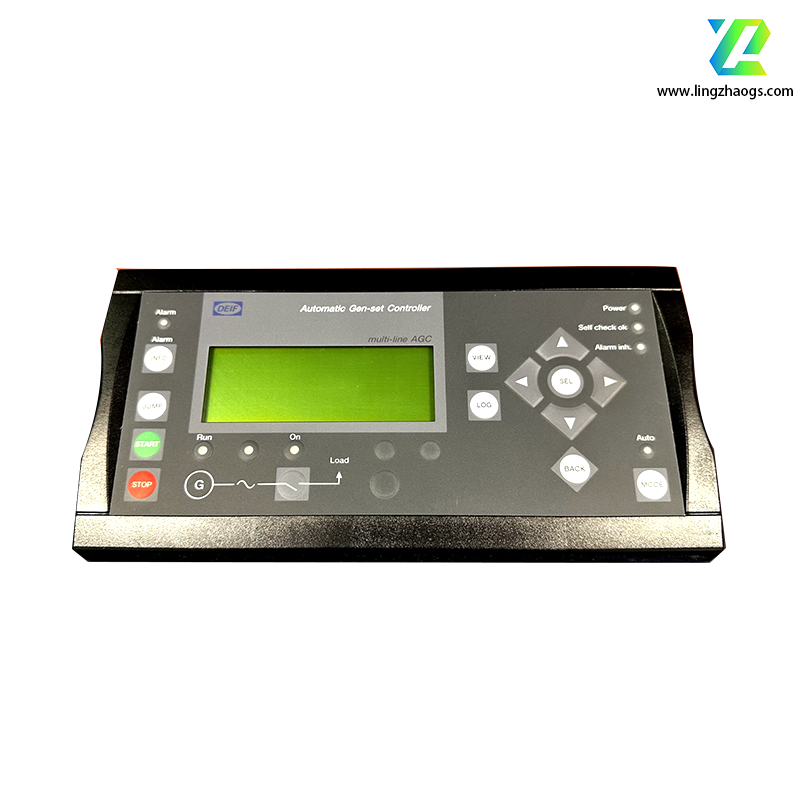Here’s a detailed overview of DEIF DU-2 (DEIF A/S part number) based on industrial control system references, DEIF’s product line standards, and third-party distributor data. As a human-machine interface (HMI) device, this part aligns with DEIF’s focus on intuitive monitoring and control for power systems, marine applications, and industrial automation. For official specifications, consult DEIF A/S directly.
- Brand: DEIF A/S (a global provider of power control, monitoring, and automation solutions)
- Model: DU-2
- Type: Compact Digital Display Unit / HMI (Human-Machine Interface)
- Industry: Marine (merchant ships, offshore vessels), power generation (diesel gensets, renewable energy), industrial backup power, and microgrids.
- Function: Serves as a local monitoring and control interface for DEIF’s power management systems (PMS), genset controllers (e.g., DGC-2020), and automation systems. It displays real-time operational data (e.g., voltage, current, genset status) and allows manual control inputs (e.g., start/stop gensets, reset alarms) via a user-friendly interface. Its compact design makes it suitable for space-constrained environments like engine rooms or control panels.
Intuitive Display & User Interface
- Equipped with a monochrome or color LCD screen (estimated 2.4–4.3 inches, based on DEIF’s compact DU series). The display shows critical parameters in clear, configurable layouts (e.g., numeric values, bar graphs, status icons).
- Features tactile pushbuttons or a membrane keypad for manual operations (e.g., navigating menus, confirming commands) — designed for reliable use in harsh industrial/marine environments (resistant to dust and moisture).
Real-Time Data Monitoring
- Preconfigured to display core power system and genset parameters:
- Electrical parameters: AC voltage, current, frequency, power (kW/kVA), power factor (PF).
- Operational status: Genset running/stopped, circuit breaker position (open/closed), load sharing status.
- Alarms & events: Visual and audible alerts for faults (e.g., low oil pressure, overspeeding) with timestamped event logs (stores last 50–100 events).
Local Control Capabilities
- Enables manual control of connected devices without relying on a central HMI or SCADA system:
- Genset control: Start/stop, emergency stop, and synchronization (when paired with DEIF PMS).
- Alarm management: Acknowledge alarms, reset fault conditions, and view alarm history.
- Parameter adjustment: Modify basic settings (e.g., genset rated speed, alarm thresholds) via password-protected menus to prevent unauthorized changes.
Rugged Design for Harsh Environments
- Built to withstand marine and industrial conditions:
- Ingress Protection (IP) Rating: IP65 (dust-tight and protected against water jets) for standalone installation in engine rooms or offshore platforms.
- Vibration/Shock Resistance: Compliant with IEC 60068-2-6 (vibration, 10–500 Hz) and IEC 60068-2-27 (shock, 30g peak acceleration) — durable for use near rotating machinery.
Display & Interface
- Screen Type: LCD (monochrome or color, backlit for low-light visibility).
- Screen Size: Estimated 2.4–4.3 inches (compact form factor for panel mounting).
- User Input: 4–8 tactile pushbuttons (membrane keypad option available).
- Audible Alarm: Built-in buzzer (85 dB) for fault alerts (muteable via keypad).
Electrical Parameters
- Power Supply: 24V DC (nominal, standard for DEIF modules), with a tolerance range of 18–32V DC. Optional 12V DC variant available for small-scale systems (verify with DEIF).
- Power Consumption: ≤5W (low power draw, suitable for battery-backed systems).
- Communication Interfaces:
- 1 x RS-485 port (Modbus RTU) for communication with DEIF controllers (e.g., DGC-2020, PMS 300).
- Optional CAN bus port (for marine genset networks, e.g., NMEA 2000).
Physical & Environmental Attributes
- Form Factor: Panel-mount design (cutout dimensions estimated 70 mm × 50 mm) for integration into control cabinets or genset local panels.
- Dimensions: Approximately 80 mm × 60 mm × 30 mm (depth) — compact for space-constrained areas.
- Environmental Ratings:
- Operating Temperature: -25°C to +70°C (suits extreme climates, from cold storage to engine rooms).
- Humidity: 5–95% (non-condensing), resistant to moisture in marine environments.
- Salt Spray Resistance: Compliant with IEC 60068-2-52 (suitable for offshore applications).
Certifications & Compliance
- Marine Certifications: Likely certified by DNV GL, ABS, Lloyd’s Register (LR), and Bureau Veritas (BV) for use in merchant and offshore vessels.
- Industrial Standards: Compliant with IEC 61000-6-2 (EMC immunity) and IEC 61000-6-4 (EMC emissions) to avoid interference with nearby electronics.
- Marine Genset Control:
- Local HMI for marine gensets, displaying parameters like fuel level, cooling water temperature, and electrical output. Allows crew to start/stop gensets and troubleshoot alarms directly from the engine room.
- Industrial Backup Power:
- Mounted on diesel gensets in data centers, hospitals, or factories to provide on-site monitoring and control. Enables technicians to check genset status without accessing a central control room.
- Renewable Energy Systems:
- Interface for small-scale solar or wind power systems, displaying energy production, battery charge level, and system status. Supports manual adjustment of power distribution settings.
- Microgrid Monitoring:
- Local display for DEIF-controlled microgrids (e.g., remote communities, military bases), showing load distribution, renewable energy input, and battery storage status.
- Condition: Available as new OEM (through DEIF A/S or authorized distributors) or genuine refurbished (via specialized suppliers, e.g., Marine Controls, Power Systems International).
- Warranty: 24-month warranty for new units (standard for DEIF products); refurbished units typically include a 12-month warranty.
- Documentation:
- User manuals, wiring diagrams, and configuration guides are available to DEIF customers via DEIF’s customer portal.
- Third-party distributors may provide installation notes for pairing with DEIF controllers.
- Compatible Systems:
- DEIF Genset Controllers: DGC-2020, DGC-300, DGC-150.
- DEIF Power Management Systems: PMS 300, PMS 400.
- DEIF Automation Controllers: AGC-400, MTC-300.
- Similar DEIF Models:
- DEIF DU-4: Larger HMI with a 4.3–7-inch color touchscreen (for more complex data visualization).
- DEIF DU-1: Basic digital display (no control functions) for simple parameter monitoring (e.g., only voltage/frequency).
- Setup Requirements:
- Panel-mount in a control cabinet or genset local panel using the provided cutout template. Ensure the front face is accessible for user interaction (avoid mounting in confined spaces).
- Configure via DEIF’s PC-Tool software to select displayed parameters, set alarm thresholds, and define communication settings (baud rate, Modbus address).
- Wiring Guidelines:
- Connect power and communication cables using the terminal block (use 0.5–1.5 mm² copper wire). Secure wiring to prevent loosening from vibration.
- Use shielded cable for the RS-485 communication line; ground the shield at the controller end to minimize EMI interference.
- Safety & Troubleshooting:
- Follow lockout-tagout (LOTO) procedures when wiring the module to live power systems.
- Use built-in diagnostics to resolve issues:
- No display: Check power supply voltage and wiring connections.
- Communication failure: Verify Modbus address and baud rate match the connected controller.
- Unresponsive keypad: Inspect for physical damage (e.g., dust or moisture ingress) and clean the keypad if needed.
- Model Functionality: The DU-2 is a local HMI with basic control — it cannot replace DEIF’s central PMS or SCADA systems for large-scale power network management. It is designed for on-site, device-level operation.
- Display Customization: The number of configurable parameters is limited by the screen size. Prioritize critical data (e.g., genset status, alarms) during setup to avoid cluttered displays.
- Genuine Parts Recommendation: Use genuine DEIF DU-2 units for marine and safety-critical applications. Aftermarket alternatives may not meet IP65 or marine certification standards, risking failure in harsh environments.
For further technical assistance, contact DEIF A/S’s global support team or your local authorized service provider. Always validate specifications against your system’s monitoring and control requirements before installation.



